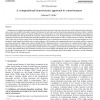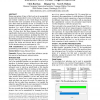418 search results - page 24 / 84 » Computational primitives of visual perception |
ISVC
2009
Springer
14 years 1 months ago
2009
Springer
While realistic illumination significantly improves the visual quality and perception of rendered images, it is often very expensive to compute. In this paper, we propose a new al...
NN
2007
Springer
13 years 6 months ago
2007
Springer
Simultaneous recordings from populations of neurons in the inferior temporal visual cortex show that most of the information about which stimulus was shown is available in the num...
CHI
2010
ACM
14 years 2 months ago
2010
ACM
Human perception of time is fluid, and can be manipulated in purposeful and productive ways. In this note, we propose and evaluate variations on two visual designs for progress ba...
IV
2005
IEEE
14 years 1 months ago
2005
IEEE
We have developed a visual syntax for representing concepts that are contingent on temporal properties (timedependent semantics). A within-group (N=24) experiment was conducted to...
VIS
2007
IEEE
14 years 8 months ago
2007
IEEE
Conveying shape using feature lines is an important visualization tool in visual computing. The existing feature lines (e.g., ridges, valleys, silhouettes, suggestive contours, etc...


